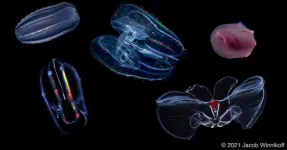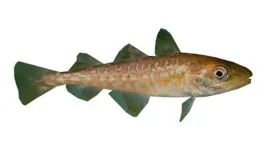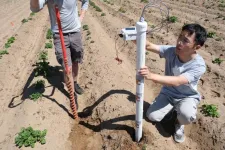(Press-News.org) CAMBRIDGE, MA — Researchers from MIT and the University of Michigan have discovered a new way to drive chemical reactions that could generate a wide variety of compounds with desirable pharmaceutical properties.
These compounds, known as azetidines, are characterized by four-membered rings that include nitrogen. Azetidines have traditionally been much more difficult to synthesize than five-membered nitrogen-containing rings, which are found in many FDA-approved drugs.
The reaction that the researchers used to create azetidines is driven by a photocatalyst that excites the molecules from their ground energy state. Using computational models that they developed, the researchers were able to predict compounds that can react with each other to form azetidines using this kind of catalysis.
“Going forward, rather than using a trial-and-error process, people can prescreen compounds and know beforehand which substrates will work and which ones won't,” says Heather Kulik, an associate professor of chemistry and chemical engineering at MIT.
Kulik and Corinna Schindler, a professor of chemistry at the University of Michigan, are the senior authors of the study, which appears today in Science. Emily Wearing, recently a graduate student at the University of Michigan, is the lead author of the paper. Other authors include University of Michigan postdoc Yu-Cheng Yeh, MIT graduate student Gianmarco Terrones, University of Michigan graduate student Seren Parikh, and MIT postdoc Ilia Kevlishvili.
Light-driven synthesis
Many naturally occurring molecules, including vitamins, nucleic acids, enzymes and hormones, contain five-membered nitrogen-containing rings, also known as nitrogen heterocycles. These rings are also found in more than half of all FDA-approved small-molecule drugs, including many antibiotics and cancer drugs.
Four-membered nitrogen heterocycles, which are rarely found in nature, also hold potential as drug compounds. However, only a handful of existing drugs, including penicillin, contain four-membered heterocycles, in part because these four-membered rings are much more difficult to synthesize than five-membered heterocycles.
In recent years, Schindler’s lab has been working on synthesizing azetidines using light to drive a reaction that combines two precursors, an alkene and an oxime. These reactions require a photocatalyst, which absorbs light and passes the energy to the reactants, making it possible for them to react with each other.
“The catalyst can transfer that energy to another molecule, which moves the molecules into excited states and makes them more reactive. This is a tool that people are starting to use to make it possible to make certain reactions occur that wouldn't normally occur,” Kulik says.
Schindler’s lab found that while this reaction sometimes worked well, other times it did not, depending on which reactants were used. They enlisted Kulik, an expert in developing computational approaches to modeling chemical reactions, to help them figure out how to predict when these reactions will occur.
The two labs hypothesized that whether a particular alkene and oxime will react together in a photocatalyzed reaction depends on a property known as the frontier orbital energy match. Electrons that surround the nucleus of an atom exist in orbitals, and quantum mechanics can be used to predict the shape and energies of these orbitals. For chemical reactions, the most important electrons are those in the outermost, highest energy (“frontier”) orbitals, which are available to react with other molecules.
Kulik and her students used density functional theory, which uses the Schrödinger equation to predict where electrons could be and how much energy they have, to calculate the orbital energy of these outermost electrons.
These energy levels are also affected by other groups of atoms attached to the molecule, which can change the properties of the electrons in the outermost orbitals.
Once those energy levels are calculated, the researchers can identify reactants that have similar energy levels when the photocatalyst boosts them into an excited state. When the excited states of an alkene and an oxime are closely matched, less energy is required to boost the reaction to its transition state — the point at which the reaction has enough energy to go forward to form products.
Accurate predictions
After calculating the frontier orbital energies for 16 different alkenes and nine oximes, the researchers used their computational model to predict whether 18 different alkene-oxime pairs would react together to form an azetidine. With the calculations in hand, these predictions can be made in a matter of seconds.
The researchers also modeled a factor that influences the overall yield of the reaction: a measure of how available the carbon atoms in the oxime are to participate in chemical reactions.
The model’s predictions suggested that some of these 18 reactions won’t occur or won’t give a high enough yield. However, the study also showed that a significant number of reactions are correctly predicted to work.
“Based on our model, there's a much wider range of substrates for this azetidine synthesis than people thought before. People didn't really think that all of this was accessible,” Kulik says.
Of the 27 combinations that they studied computationally, the researchers tested 18 reactions experimentally, and they found that most of their predictions were accurate. Among the compounds they synthesized were derivatives of two drug compounds that are currently FDA-approved: amoxapine, an antidepressant, and indomethacin, a pain reliever used to treat arthritis.
This computational approach could help pharmaceutical companies predict molecules that will react together to form potentially useful compounds, before spending a lot of money to develop a synthesis that might not work, Kulik says. She and Schindler are continuing to work together on other kinds of novel syntheses, including the formation of compounds with three-membered rings.
“Using photocatalysts to excite substrates is a very active and hot area of development, because people have exhausted what you can do on the ground state or with radical chemistry,” Kulik says. “I think this approach is going to have a lot more applications to make molecules that are normally thought of as really challenging to make.”
END
Scientists use computational modeling to guide a difficult chemical synthesis
Using this new approach, researchers could develop drug compounds with unique pharmaceutical properties.
2024-06-27
ELSE PRESS RELEASES FROM THIS DATE:
The worm has turned: DIY lab platform evaluates new molecules in minutes
2024-06-27
Plants are powerhouses of molecular manufacturing. Over the eons, they have evolved to produce a plethora of small molecules — some are beneficial and valuable to humans, others can be deadly. For years, a good way for scientists looking for new medicines to distinguish beneficial plant-derived molecules from harmful ones has been through a scientific sniff test — dab a bit of the molecule at one end of a petri dish and drop tiny nematode worms (C. elegans) at the other, then wait to see if the chemically sensitive worms move toward or away from the compound in question, a process known as chemotaxis.
This “artisanal” ...
Under pressure: How comb jellies have adapted to life at the bottom of the ocean
2024-06-27
The bottom of the ocean is not hospitable: there is no light; the temperature is freezing cold; and the pressure of all the water above will literally crush you. The animals that live at this depth have developed biophysical adaptations that allow them to survive in these harsh conditions. What are these adaptations and how did they develop?
University of California San Diego Assistant Professor of Chemistry and Biochemistry Itay Budin teamed up with researchers from around the country to study the cell membranes of ctenophores (“comb jellies”) and found they had unique lipid structures that allow them to live under intense pressure. Their work appears in Science.
Adapting ...
A CHARMed collaboration created a potent therapy candidate for fatal prion diseases
2024-06-27
EMBARGOED UNTIL 27-Jun-2024 14:00 ET
Drug development is typically slow: the pipeline from basic research discoveries that provide the basis for a new drug to clinical trials to production of a widely available medicine can take decades. But decades can feel impossibly far off to someone who currently has a fatal disease. Broad Institute Senior Group Leader Sonia Vallabh is acutely aware of that race against time, because the topic of her research is a neurodegenerative and ultimately fatal disease–fatal familial insomnia, a type of prion disease–that she will almost certainly develop as she ages. Vallabh and her husband, Eric Minikel, switched careers ...
Researchers find flexible solution for separating gases
2024-06-27
For a broad range of industries, separating gases is an important part of both process and product—from separating nitrogen and oxygen from air for medical purposes to separating carbon dioxide from other gases in the process of carbon capture or removing impurities from natural gas.
Separating gases, however, can be both energy-intensive and expensive. “For example, when separating oxygen and nitrogen, you need to cool the air to very low temperatures until they liquefy. Then, by slowly increasing the temperature, the gases will evaporate at different points, allowing one to become a gas again and separate out,” explains Wei Zhang, a University of Colorado Boulder professor ...
Pacific cod can’t rely on coastal safe havens for protection during marine heat waves, OSU study finds
2024-06-27
During recent periods of unusually warm water in the Gulf of Alaska, young Pacific cod in near shore safe havens where they typically spend their adolescence did not experience the protective effects those areas typically provide, a new Oregon State University study found.
Instead, during marine heat waves in 2014-16 and 2019, young cod in these near shore “nurseries” around Kodiak Island in Alaska experienced significant changes in their abundance, growth rates and diet, with researchers estimating that only the largest 15-25% of the island’s cod population survived the summer. Even after the high temperatures subsided, the ...
Bird flu stays stable on milking equipment for at least one hour
2024-06-27
Bird flu, or H5N1 virus, in unpasteurized milk is stable on metal and rubber components of commercial milking equipment for at least one hour, increasing its potential to infect people and other animals, report researchers from the University of Pittsburgh School of Medicine and Emory University in Emerging Infectious Diseases.
The study underscores the heightened risk of bird flu exposure for dairy farm workers and signals the need for wider adoption of personal protective equipment, including face shields, masks and eye protection.
“Dairy cows have to be milked even if they are sick, and it has not been clear for how long the virus contained in residual milk from the ...
Printed sensors in soil could help farmers improve crop yields and save money
2024-06-27
MADISON — University of Wisconsin–Madison engineers have developed low-cost sensors that allow for real-time, continuous monitoring of nitrate in soil types that are common in Wisconsin. These printed electrochemical sensors could enable farmers to make better informed nutrient management decisions and reap economic benefits.
“Our sensors could give farmers a greater understanding of the nutrient profile of their soil and how much nitrate is available for the plants, helping them to make more precise decisions on how much fertilizer they really need,” says Joseph Andrews, an assistant professor of mechanical ...
Neighborhood opportunities influence infant development and cognition
2024-06-27
Growing up in neighborhoods with more educational and socioeconomic opportunities has a positive impact on infants’ brain activity, according to new research from Boston Medical Center (BMC). The study, published in The Journal of Developmental & Behavioral Pediatrics, suggests that enhancing neighborhood opportunities, particularly in education, can be a promising approach to promoting early childhood development.
A team of early childhood researchers examined how neighborhood opportunity – the socioeconomic, educational, health, and ...
New twists on tornadoes: Earth scientist studies why U.S. has so many tornadoes
2024-06-27
WEST LAFAYETTE, Ind. — Across the Midwest during the warmer months, studying the sky for signs of storms and tornadoes becomes one of the most popular pastimes.
Dan Chavas, an associate professor in the Department of Earth, Atmospheric, and Planetary Sciences at Purdue University’s College of Science, takes it further: All day every day, he studies what makes tornadoes tick. Working at the intersection of climate science and meteorology, he looks at the big picture of what causes severe storms and tornadoes — and what dictates where ...
Children’s Hospital of Philadelphia researchers find elementary age children experience more concussions during activities unrelated to sports
2024-06-27
Philadelphia, June 27, 2024 – Researchers from Children’s Hospital of Philadelphia (CHOP) found that young children between the ages of 5 and 12 were more likely to experience a concussion from recreation and other non-sport activities, yet those injuries were not seen by specialists until days later compared with sports-related concussions in the same age group.
This study suggests concussion research is needed for children outside of sports and that providing more resources and education ...
LAST 30 PRESS RELEASES:
Quantum ‘alchemy’ made feasible with excitons
‘Revoice’ device gives stroke patients their voice back
USF-led study: AI helps reveal global surge in floating algae
New method predicts asthma attacks up to five years in advance
Researchers publish first ever structural engineering manual for bamboo
National poll: Less than half of parents say swearing is never OK for kids
Decades of suffering: Long-term mental health outcomes of Kurdish chemical gas attacks
Interactional dynamics of self-assessment and advice in peer reflection on microteaching
When aging affects the young: Revealing the weight of caregiving on teenagers
Can Canada’s health systems handle increased demand during FIFA World Cup?
Autistic and non-autistic faces may “speak a different language” when expressing emotion
No clear evidence that cannabis-based medicines relieve chronic nerve pain
Pioneering second-order nonlinear vibrational nanoscopy for interfacial molecular systems beyond the diffraction limit
Bottleneck in hydrogen distribution jeopardises billions in clean energy
Lung cancer death rates among women in Europe are finally levelling off
Scientists trace microplastics in fertilizer from fields to the beach
The Lancet Obstetrics, Gynecology, & Women’s Health: Taking paracetamol during pregnancy does not increase risk of autism, ADHD or intellectual disabilities, confirms new gold-standard evidence review
Taking paracetamol during pregnancy does not increase risk of autism, ADHD or intellectual disabilities
Harm reduction vending machines in New York State expand access to overdose treatment and drug test strips, UB studies confirm
University of Phoenix releases white paper on Credit for Prior Learning as a catalyst for internal mobility and retention
Canada losing track of salmon health as climate and industrial threats mount
Molecular sieve-confined Pt-FeOx catalysts achieve highly efficient reversible hydrogen cycle of methylcyclohexane-toluene
Investment in farm productivity tools key to reducing greenhouse gas
New review highlights electrochemical pathways to recover uranium from wastewater and seawater
Hidden pollutants in shale gas development raise environmental concerns, new review finds
Discarded cigarette butts transformed into high performance energy storage materials
Researchers highlight role of alternative RNA splicing in schizophrenia
NTU Singapore scientists find new way to disarm antibiotic-resistant bacteria and restore healing in chronic wounds
Research suggests nationwide racial bias in media reporting on gun violence
Revealing the cell’s nanocourier at work
[Press-News.org] Scientists use computational modeling to guide a difficult chemical synthesisUsing this new approach, researchers could develop drug compounds with unique pharmaceutical properties.



